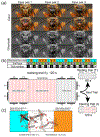Color is necessary for face discrimination in the Northern paper wasp, Polistes fuscatus
- PMID: 36245014
- PMCID: PMC9974887
- DOI: 10.1007/s10071-022-01691-9
Color is necessary for face discrimination in the Northern paper wasp, Polistes fuscatus
Abstract
Visual individual recognition requires animals to distinguish among conspecifics based on appearance. Though visual individual recognition has been reported in a range of taxa including primates, birds, and insects, the features that animals require to discriminate between individuals are not well understood. Northern paper wasp females, Polistes fuscatus, possess individually distinctive color patterns on their faces, which mediate individual recognition. However, it is currently unclear what role color plays in the facial recognition system of this species. Thus, we sought to test two possible roles of color in wasp facial recognition. On one hand, color may be important simply because it creates a pattern. If this is the case, then wasps should perform similarly when discriminating color or grayscale images of the same faces. Alternatively, color itself may be important for recognition of an image as a "face", which would predict poorer performance on grayscale discrimination relative to color images. We found wasps performed significantly better when discriminating between color faces compared to grayscale versions of the same faces. In fact, wasps trained on grayscale faces did not perform better than chance, indicating that color is necessary for the recognition of an image as a face by the wasp visual system.
Keywords: Color; Face discrimination; Individual recognition; Operant conditioning; Polistes fuscatus; Vision.
© 2022. The Author(s), under exclusive licence to Springer-Verlag GmbH Germany, part of Springer Nature.
Conflict of interest statement
Competing interests
Authors declare no conflicts of interest.
Figures


References
-
- AVILéS JM, VIKAN JR, FOSSØY F, ANTONOV A, MOKSNES A, RØSKAFT E & STOKKE BG 2010. Avian colour perception predicts behavioural responses to experimental brood parasitism in chaffinches. Journal of Evolutionary Biology, 23, 293–301. - PubMed
-
- BATES D, MÄCHLER M, BOLKER B & WALKER S 2015. Fitting linear mixed-effects models using lme4. Journal of Statistical Software, 67, 1–48.
-
- BEANI L, BAGNÈRES AG, ELIA M, PETROCELLI I, CAPPA F & LORENZI MC 2019. Cuticular hydrocarbons as cues of sex and health condition in Polistes dominula wasps. Insectes Sociaux, 66, 543–553.
-
- BEECHER MD 1989. Signalling systems for individual recognition: an information theory approach. Animal Behaviour, 38, 248–261.
MeSH terms
Grants and funding
LinkOut - more resources
Full Text Sources

